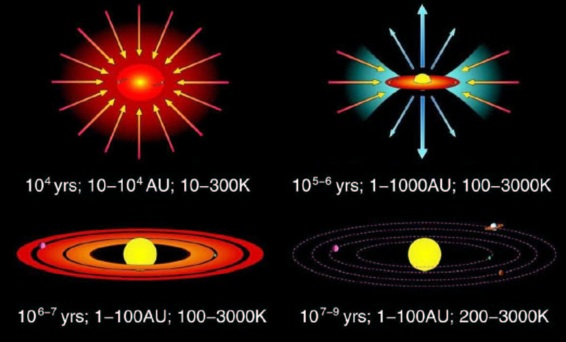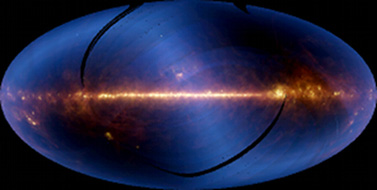Axial and Orbital Rotations
© Charles ChandlerIn the standard model, the planets in our solar system formed from the same accretion disc as the Sun. (See Figure 1.)This would seem to explain why all of the planets orbit the Sun in the same direction that the Sun rotates on its axis, if all of it condensed from the same disc, and if the disc was rotating.But this doesn't explain why all of the rotations that we can detect, including the orbits within our solar system, and the rotations of planetary nebulae, are aligned to the external magnetic fields, far beyond chance.1,2,3,4 This suggests that the particles involved in the radial implosion were charged, and thus developed a spin due to the Lorentz force. The galactic magnetic field is extremely weak, and yet the total angular momentum in the solar system is extremely small, given the size of the dusty plasma from which it condensed. An extremely weak force, acting on matter over a long period of time, traveling a great distance, can certainly induce a small rotation.This also explains the predominantly prograde axial spins in our solar system, which the standard model cannot. To think that planets would rotate on their axes in the same direction that they rotate around the Sun, for the same reason, is naïve, and if we take a close look at the actual forces involved, we find that Newtonian forces should dictate retrograde axial spins. Angular velocities increase with proximity to the axis of rotation. (See Figure 2.) This means that if all of the matter within a strip of the disc condenses, the net angular momentum within that strip is retrograde. For example, the general rotation in Figure 2 is counter-clockwise in top view. But if all of the particles within the extents of the three outer shells condensed into one body, that body would rotate clockwise (i.e., retrograde), since the left shoulder (i.e., the inner matter) will be traveling faster than the right shoulder (i.e., the outer matter), facing in the direction of the orbital rotation. This left/right momentum should be quite respectable, and the same weak Lorentz force that induced the overall rotation shouldn't be capable of overpowering it. This makes it difficult to image how the planets condensed from strips within the accretion disc. It's easier to believe that irregularities in the collapsing dusty plasma meant that not all of it collapsed on precisely the same point. Rather, there were multiple nuclei of condensation. The matter converging on each of these points will have angular momenta, in the same direction, and for the same reason, but each as a separate instance, not as components of a single system.Then there is the exception that proves the rule. The one planet that does have a retrograde axial rotation (i.e., Venus) is slowing down. Without any moons, tidal forces are weak, and thus tidal friction cannot account for the loss of angular momentum. Friction from atmospheric winds cannot be the cause, since they are retrograde as well, and rotate much faster than the solid surface, so they should speed up the retrograde rotation. This can only mean that there is another force, which can only be the external magnetic field. So the same Lorentz force that induced the rotation in the first place is still at work.Note that for the external magnetic field to have any effect on the axial rotation of a planet, the planet has to have a net charge. This, of course, is problematic, since there is no reason to believe that a planet could sustain a net charge for any length of time, in the absence of sufficient resistance. Yet there is a way for a net neutral planet to act as if it has a net charge. If the planet is made up of current-free double-layers (CFDLs), the charges might all be in equilibrium, but the outer layer will have more torque. On Venus, when we see that the atmosphere's retrograde rotation is currently getting accelerated, while the solid sphere's rotation is getting decelerated, we can conclude that it's the same force at work in both cases, but the atmosphere has a different charge from the solid surface. So the Lorentz force sends oppositely charged layers in opposite directions. Similarly, when we observe counter-rotating bands in the atmosphere of Jupiter (as in Figure 3), these can only be oppositely charged chemicals accelerated in a magnetic field.More Issues to Explore
- axial and orbital precession
- What if the Earth's precession is a consequence of the event that put the Moon into orbit around the Earth? My working hypothesis is that the Moon was the impacter, while Celeste is talking about a perfect near miss of a much larger body, which created a tidal bulge that split off to form the Moon. Either way, if the force applied to the Earth wasn't perfectly in line with the Earth's existing rotation, precession would have resulted.
- Another possibility is that the galactic magnetic field is not perpendicular to the plane of orbital rotation. I like that better than my axial magnetic conflict idea for precession, because the latter doesn't explain why other planets don't precess.
Axial Precession planet angular
radiusperiod
(years)Mercury Venus Earth 23.5° 25,771 Mars 25.2° 178,000 Jupiter 3.1° 500,000 Saturn 26.7° 1,800,000 Uranus Neptune 29.4° 23,000,000
- correlation between orbital inclination and aspect ratio of elliptical orbit (the ellipses projected onto the invariable plane are all circles)
Orbital Inclination planet ecliptic equatorial invariable Mercury 7.01° 3.38° 6.34° Venus 3.39° 3.86° 2.19° Earth 0.00° 7.16° 1.57° Mars 1.85° 5.65° 1.67° Jupiter 1.31° 6.09° 0.32° Saturn 2.49° 5.51° 0.93° Uranus 0.77° 6.48° 1.02° Neptune 1.77° 6.43° 0.72°
- Bode's Law
- Orbits of planets increase at a regular rate.
- Charles Chandler: electrostatic/gravitational equilibrium
- Chad Glass: electrical resonance
- The orbits and prograde rotations are cloned signals in sympathetic electrical resonance with the parent star (Sun). Realize that per spiraling helix oribts these are actually sine waves. These sine waves are electrically induced and overridden/established by the Sun as the primary node of the signal. Orbits, then, are ancillary and/or cloned facsimiles of the Sun's dominating electrical wave envelope. The Sun induces a literal dance of the particles around it.
- Once a planet is born of and/or enters the Sun's plasma envelope, the body encounters the influence of the Sun's signal profile that is physically expressed in its rotation--the Sun being a rotating generator or motor. You could also consider it to be a voltage regulator and virtual cathode. This electrical device, the Sun, can be measured on an oscilloscope in all likelihood. This may also tie into why planets tend to "quantize" into a Titus Bode relationship. They are self-arranging as they are "signal cloned" into sympathetic positions very much like notes in a musical scale. It may also have to do with harmonics. Things will tend to vibrate and assume the waveform of adjacent dominant signals, ripples.
- rotation of entire solar system (either because the Sun is in a long period rotation with a binary companion, or because it is moving in a helical path through the spiral arm magnetic field)
References
1. Gaensler, B. M. (1999): Morphological Studies of Extragalactic Supernova Remnants. Perspectives on Radio Astronomy: Science with Large Antenna Arrays, 271-274 ⇧
2. Bhatnagar, S. (2001): Radio Study of Galactic Supernova Remnants and the Interstellar Medium. Tata Institute of Fundamental Research, Pune, India ⇧
3. Henning, T.; Li, H. (2011): The alignment of molecular cloud magnetic fields with the spiral arms in M33. Nature, 479 (7374): 499-501 ⇧
4. Beck, R. (2000): Magnetic fields in normal galaxies. Philosophical Transactions of the Royal Society of London. Series A: Mathematical, Physical and Engineering Sciences, 358 (1767): 777-796 ⇧















